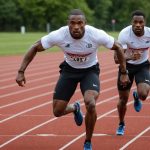Importance of Reaction Time in Badminton
In the fast-paced world of badminton, a player’s reaction time can make the difference between winning and losing. The ability to swiftly react to your opponent’s shots is crucial in maintaining an edge on the court. Quick reflexes allow players to anticipate the trajectory of the shuttlecock, position themselves appropriately, and execute precise shots. As you improve your reaction time, you enhance your overall badminton performance.
The dynamics of a badminton game change significantly with better reaction times. Players who can quickly interpret their opponent’s moves often have the upper hand, enabling them to score and defend effectively. Faster reaction time correlates with increased agility and adaptability during intense rallies, showing the profound impact on both offensive and defensive strategies.
Additional reading : Unlocking Optimal Endurance: The Ultimate Guide to Monitoring Heart Rate Variability for Runners
Psychological factors also play a pivotal role in a player’s reaction time. Stress, anxiety, and fatigue can delay response times, affecting performance. Mental conditioning, focusing techniques, and maintaining a calm disposition can mitigate these effects, allowing players to react more promptly under pressure. By understanding these psychological influences, athletes can train both their minds and bodies to respond adeptly, ensuring competitive advantage and enhancing the enjoyment of the game. This dynamic creates an interesting interplay where mental fortitude and physical readiness combine to achieve peak performance.
Targeted Workouts for Enhancing Reaction Time
Tailored workouts can significantly boost players’ reaction times. Utilising specific exercises designed for speed and agility will foster improvements in performance, especially important in reactive sports like badminton.
Additional reading : Unlocking Mental Clarity: Proven Techniques to Boost Focus and Concentration in Competitive Chess Players
Plyometric Exercises
Plyometric training is essential for those seeking to augment their speed. These exercises consist of explosive movements such as jumps and bounds, impacting both the nervous system and muscle strength. Effective plyometric exercises include box jumps, squat jumps, and burpees. These movements not only enhance speed and power but also improve overall agility, crucial for quick reactions during gameplay.
Agility Drills
Badminton-specific agility drills are invaluable in developing swift footwork. Examples include ladder drills and cone drills, which focus on directional changes and enhancing reaction times. Incorporating these drills into regular practice is vital; they should be implemented at least three times a week. Players can measure their progress through agility tests, observing reductions in completion times or increased fluency in movements.
Interval Training
Interval training combines short bursts of intense activity with rest or lower-intensity periods. This training style is beneficial for boosting endurance and speed. Suggested routines for badminton players comprise sprints combined with recovery periods. Cardiovascular fitness is integral to reducing fatigue, thereby retaining quicker reaction times—indispensable for maintaining competitive edge.
Implementing Reaction Time Drills
Enhancing reaction time is crucial in badminton practice to elevate skill development. Training methods such as shadow badminton, reaction ball exercises, and partner drills significantly contribute to improving agility and reflexes efficiently.
Shadow Badminton
Shadow badminton is a technique that allows players to focus on their movement without the use of a shuttlecock. This type of training emphasises footwork and positioning, enabling a player to simulate actual game scenarios smoothly. Notably, performing shadow badminton develops muscle memory, which enhances faster and more precise responses during real matches. This approach not only builds your footwork but also fortifies your stamina over prolonged periods.
Reaction Ball Training
Reaction balls are small, uniquely shaped balls that bounce unpredictably, making them perfect for improving hand-eye coordination. Regular use in training hones your reflexes and sharpens concentration. Drills like catching the reaction ball with alternating hands or involving multiple bouncing angles introduce variety and challenge your reflexes dynamically. These exercises also promote agility as you chase and catch the erratic equipment.
Partner Drills
Engaging in partner drills focuses on improving reflexes under variable conditions. It’s essential to maintain unpredictability to replicate realistic game circumstances, gelling well with your partner’s movements. Effective communication plays a significant role in synchronising efforts, ensuring drills run smoothly. Utilize verbal cues to indicate start and stop times, enhancing coordination and boosting the overall experience.
Expert Insights on Reaction Time in Badminton
Improving reaction time in badminton is critical for sports performance, as emphasised by expert opinions. Interviews with experienced coaches reveal key training strategies they employ to enhance this aspect. Drills focusing on quick decision-making are commonly recommended. Coaches stress the significance of incorporating such exercises into regular practice sessions to acclimatise players to fast-paced environments naturally.
The science behind reaction time indicates its pivotal role in badminton. Reaction time is the interval between stimulus presentation and the initiation of a bodily response. Research shows a positive correlation between reaction-focused training and superior sports performance. This highlights the importance of targeted practices to sharpen agility and swiftness in players.
Coaching tips routinely include the integration of reaction time drills with general skill enhancement workouts. Examples of popular strategies involve shuttlecock speed drills and multi-shuttle exercises, which simulate real-game scenarios. These tactics not only improve reflexes but also build player confidence.
Testimonials from professionals underscore the benefits of reaction-focused workouts. Badminton champions consistently attribute success to their dedicated practice on enhancing their reaction times. This affirmation emphasises that effective training is a cornerstone of excellence in competitive badminton. By incorporating these expert-approved coaching tips, athletes increase their potential for securing victories on the court.
Measuring Improvement and Progress
Measuring improvement in any sport, such as badminton, requires a structured approach to performance tracking and regular assessments. Identifying key metrics, like reaction time, provides a clear picture of progress.
Performance Metrics
To accurately track improvement, certain metrics are crucial. Reaction time tests are a primary tool; they evaluate the speed at which a player responds to a shuttlecock. Tools like motion capture technology or wrist-worn sensors provide precise data for detailed analysis. These innovations have made tracking an athlete’s progress more efficient, offering insights into micro-improvements that are often overlooked. Regular badminton assessments not only gauge the player’s current capability but also inform trainers about areas that need focus. They act as a roadmap for athletes, driving them toward their performance goals.
Setting Realistic Goals
A balanced approach to setting goals is key to avoiding burnout. Goals should be achievable and consider the player’s current skill level. A well-structured workout plan is essential for maintaining focus. As training progresses, adjustments based on performance tracking results ensure that objectives remain relevant and challenging.
Staying Motivated
Motivation plays a pivotal role in consistent performance improvement. Techniques such as visualising goals and reflecting on improvements help fuel persistence. Partnering with an accountability buddy strengthens commitment, providing external motivation. Celebrating milestones in performance not only boosts morale but reinforces dedication and progress encapsulated by performance tracking.






